Monitor
1 Index Monitor
Feature Description: The Index Monitor can be used to monitor the refractive index information of materials within a selected region. It can be used in the FDTD solver or EME solver. The refractive index monitor plots the real and imaginary parts of the refractive index at the wavelength or frequency used in the simulation.
1.1 Geometry
 |
|---|
1) Name (Monitor Name): This field is used to change the name of the index monitor.
2) Monitor type: This field selects a refractive index monitor that is perpendicular to different coordinate axes. You can choose "2D X-Normal", "2D Y-Normal", or "2D Z-Normal".
3) X, Y, Z: The center position of the simulation region.
4) X Min, X Max: X min, X max position.
5) Y Min, Y Max: Y min, Y max position.
6) Z Min, Z Max: Z min, Z max position.
7) X Span, Y Span, Z Span: X, Y, Z span of the simulation region.
8) Index Preview: You can use “Index Preview” to view the refractive index distribution of the structure before running the simulation. Double click to run “Index Preview” in the drop-down box of the refractive index monitor in the Object tree.
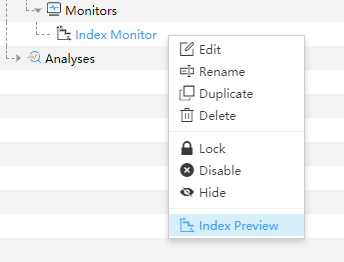 |
|---|
2 FDTD Monitors
The FDTD Monitors include the Field Time Monitor for monitoring time-domain fields, the Frequency-Domain and Power Monitor for monitoring frequency-domain fields and power, and the Global Option for global monitor settings.
2.1 Field Time monitor
Feature Description: The time-domain monitor extracts the field distribution within certain spatial regions during the FDTD simulation iterations.
2.1.1 General
The general tab for the time monitor includes options to edit the amount of data, and time period over which data is collected.
 |
|---|
1) Stop Method: The criterion for determining when the monitor stops recording. The options include End of Simulation (record until the end of the simulation), Choose Stop Time (record until the selected simulation time), and Choose Number of Snapshots (record until the selected number of simulation steps).
2) Start Time: The time to switch on recording.
3) Stop Time: The time to end recording.
4) Number of Snapshots: The number of time steps to be recorded.
2.2.2 Geometry
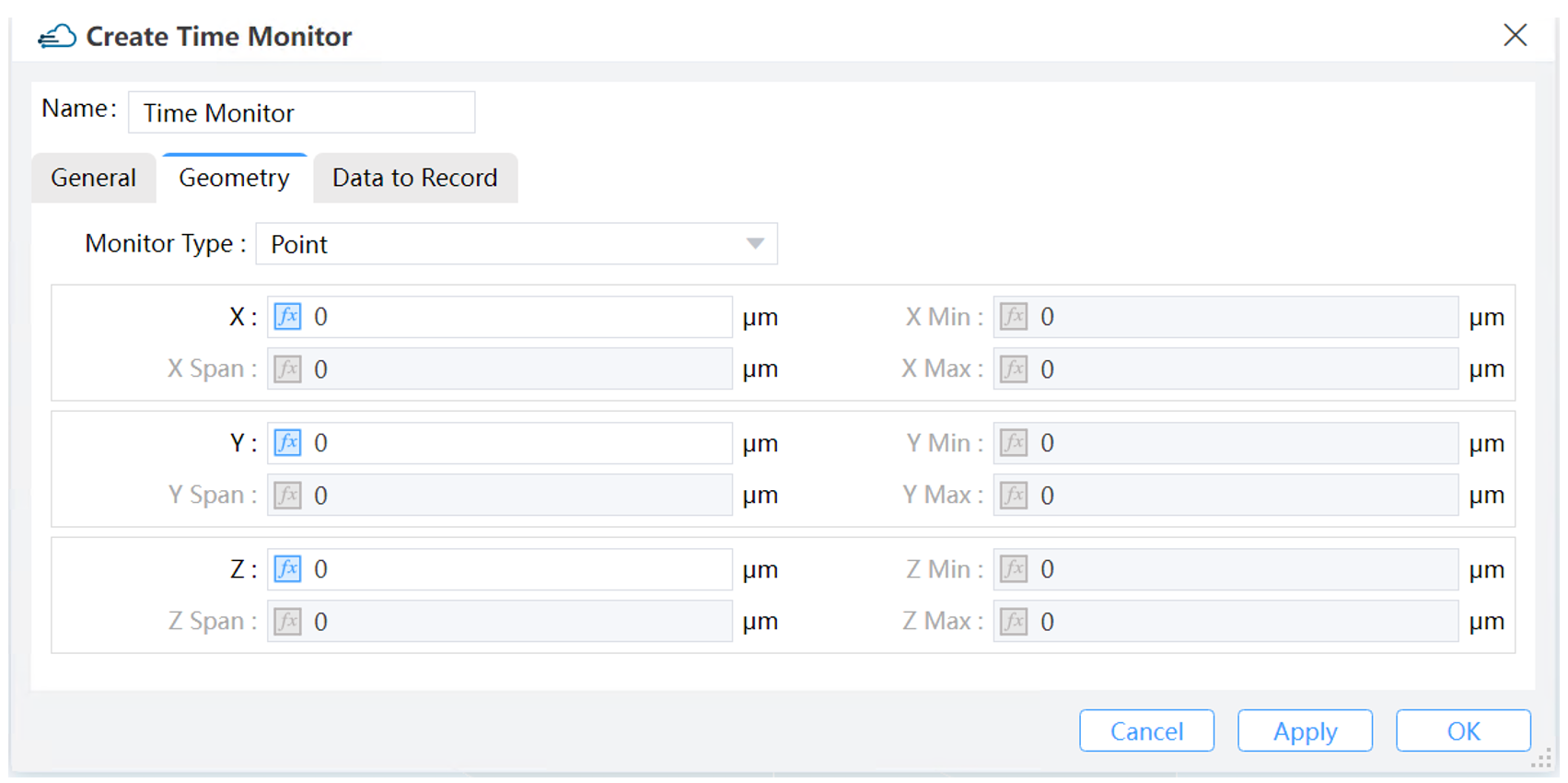 |
|---|
1) Monitor Type: This option controls the availability of the following Geometry parameter settings, including Point (point monitor), Linear X (X-direction line monitor), Linear Y (Y-direction line monitor), Linear Z (Z-direction line monitor), 2D X-Normal (2D plane monitor in the X direction), 2D Y-Normal (2D plane monitor in the Y direction), 2D Z-Normal (2D plane monitor in the Z direction), and 3D (three-dimensional monitor). The default value is Point.
2) X,Y,Z: The center position of the simulation region.
3) X Min/X Max: X min, X max position.
4) Y Min/ Y Max: Y min, Y max position.
5) Z Min/ Z Max: Z min, Z max position.
6) X Span/ Y Span / Z Span: X, Y, Z span of the simulation region.
2.2.3 Data to Record
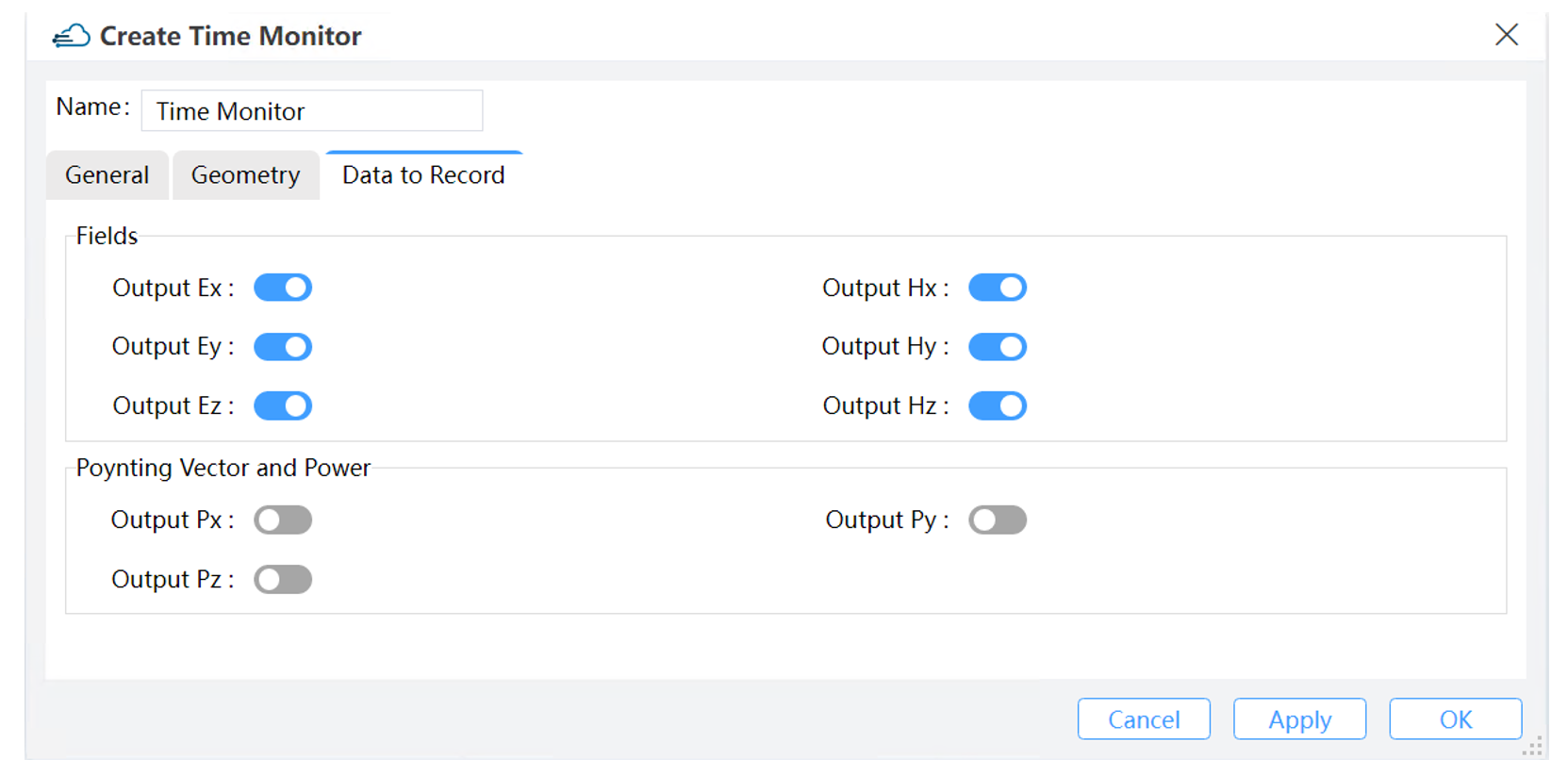 |
|---|
1) Fields: We can choose to record the electromagnetic field components of interest (e.g., Ex, Ey, Ez, Hx, Hy, Hz).
2) Poynting vector and power: The user can choose to output the Poynting Vector components of interest (Px, Py, Pz). In 2D simulations, only certain components remain non-zero in TE simulations. However, to facilitate quick switching between TE and TM simulations, all field quantities will remain activated for recording.
2.2 Frequency-Domain Field and Power Monitor
Feature Description: Frequency domain field monitors work in the frequency domain and extract the field profiles across some spatial regions of the FDTD simulation.
2.2.1 General
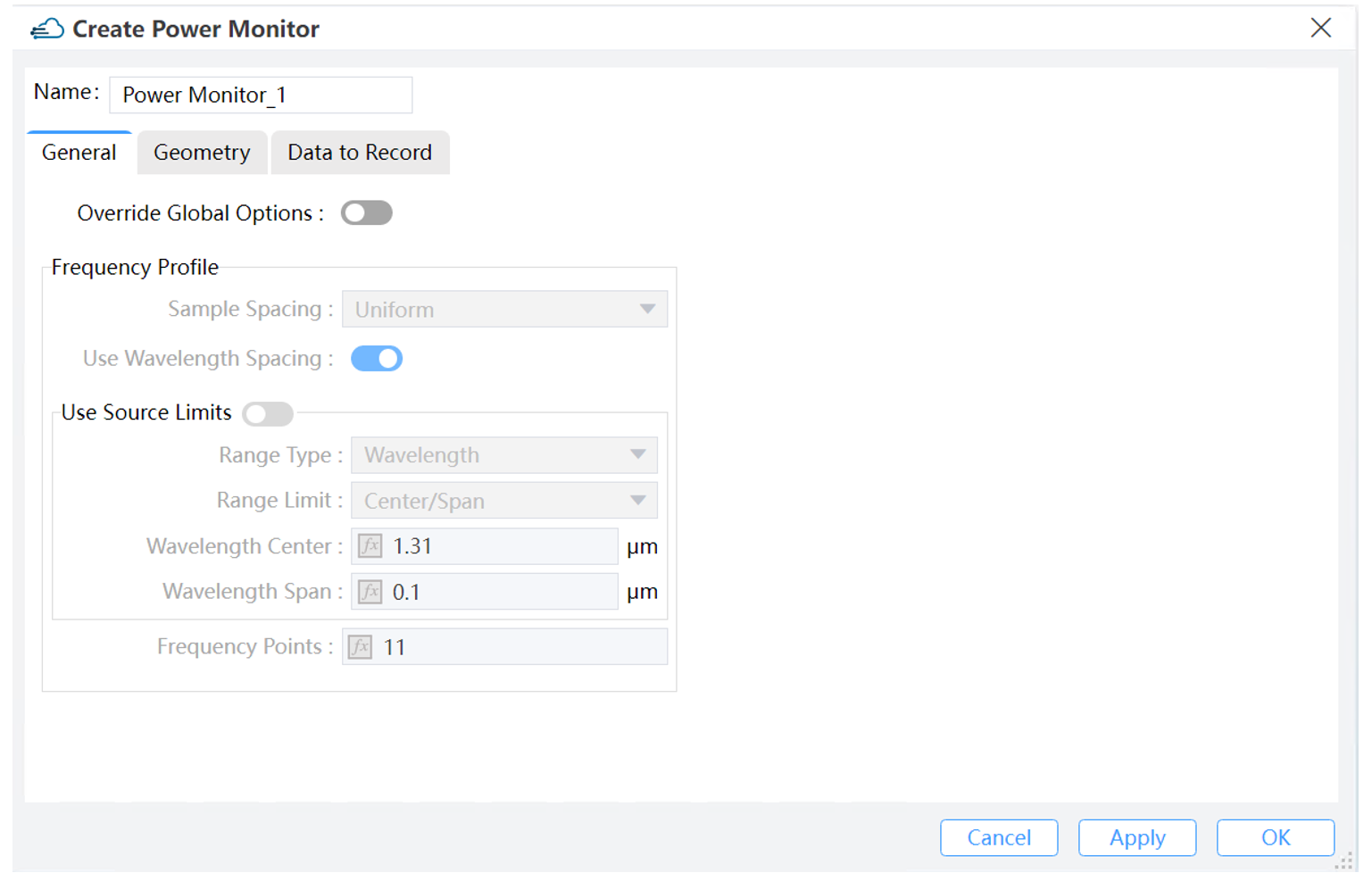 |
|---|
1) Override Global Options: This is a toggle for overriding the global monitor settings. Checking this option enables the user to specify the frequency spans and number of points at which frequency-domain data will be collected. Otherwise the following options should be specified from the global monitor settings.
2) Sample Spacing: The sampling frequency or wavelength is determined somehow based on this choice parameter. Only the "uniform" option is available at present.
3) Use Wavelength Spacing:The monitor defaults to recording frequency points at equal intervals. Select this option to take values at equal intervals relative to the wavelength of the data.
4) Use Source Limits:
Range Type: This field is used to select the type of light source range to set: wavelength or frequency.
Range Limit: This field is used to select the way to set the range of light sources: Min/Max or Center/Span.
Wavelength Min: This field sets the minimum value for monitoring wavelength.
Wavelength Max: This field sets the maximum value for monitoring wavelength.
5) Frequency Points: Sets to choose the number of frequency points at which to record data. (Default: 5)
2.2.2 Geometry
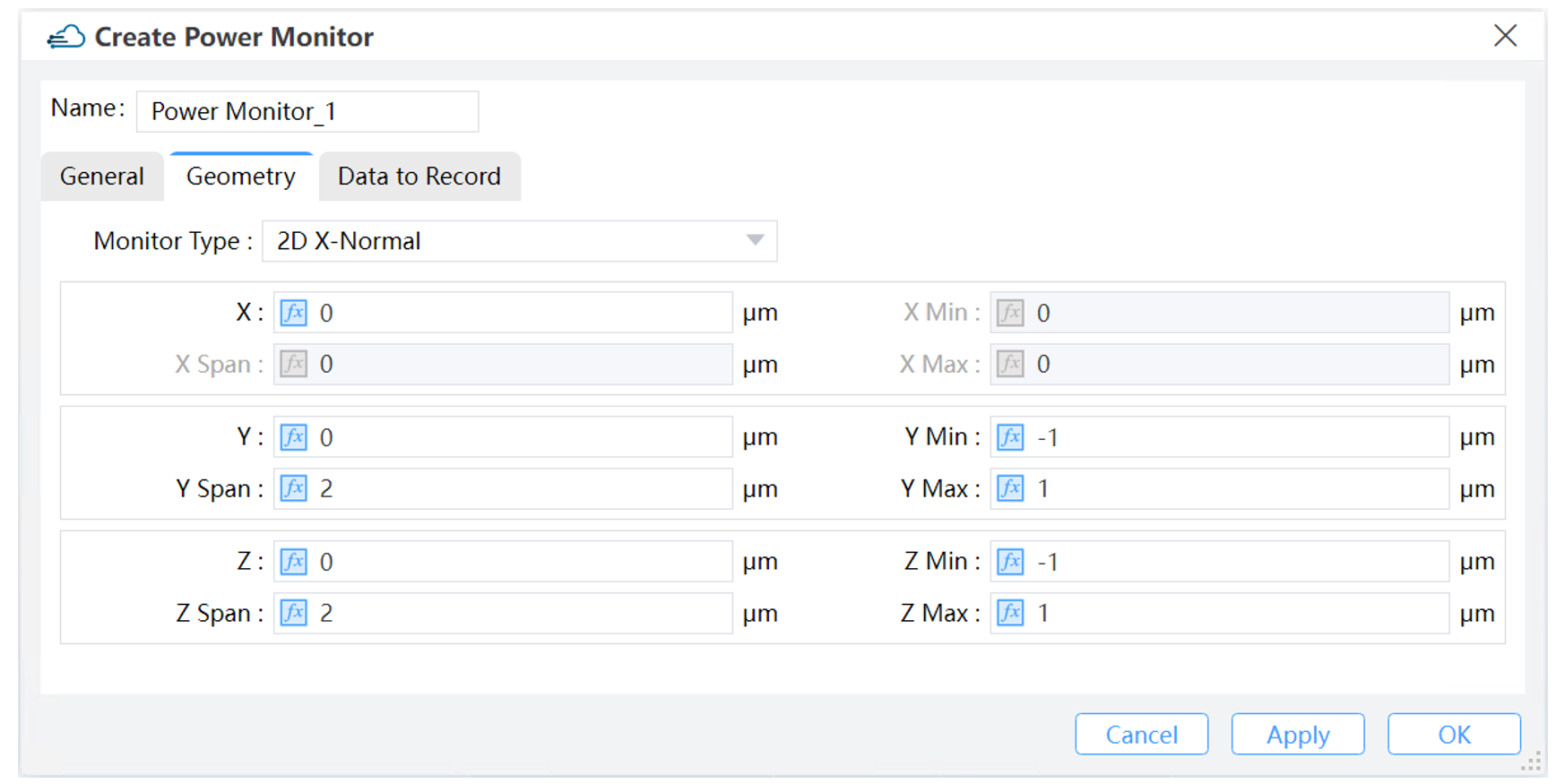 |
|---|
1) Monitor Type: This option controls the availability of the following Geometry parameter settings, including Point (point monitor), Linear X (X-direction line monitor), Linear Y (Y-direction line monitor), Linear Z (Z-direction line monitor), 2D X-Normal (2D plane monitor in the X direction), 2D Y-Normal (2D plane monitor in the Y direction), 2D Z-Normal (2D plane monitor in the Z direction), and 3D (three-dimensional monitor). The default value is 2D X-Normal.
2) X, Y, Z: The center position of the simulation region.
3) X Min, X Max: X min, X max position.
4) Y Min, Y Max: Y min, Y max position.
5) Z Min, Z Max: Z min, Z max position.
6) X SPAN, Y SPAN, Z SPAN: X, Y, Z span of the simulation region.
2.2.3 Data to Record
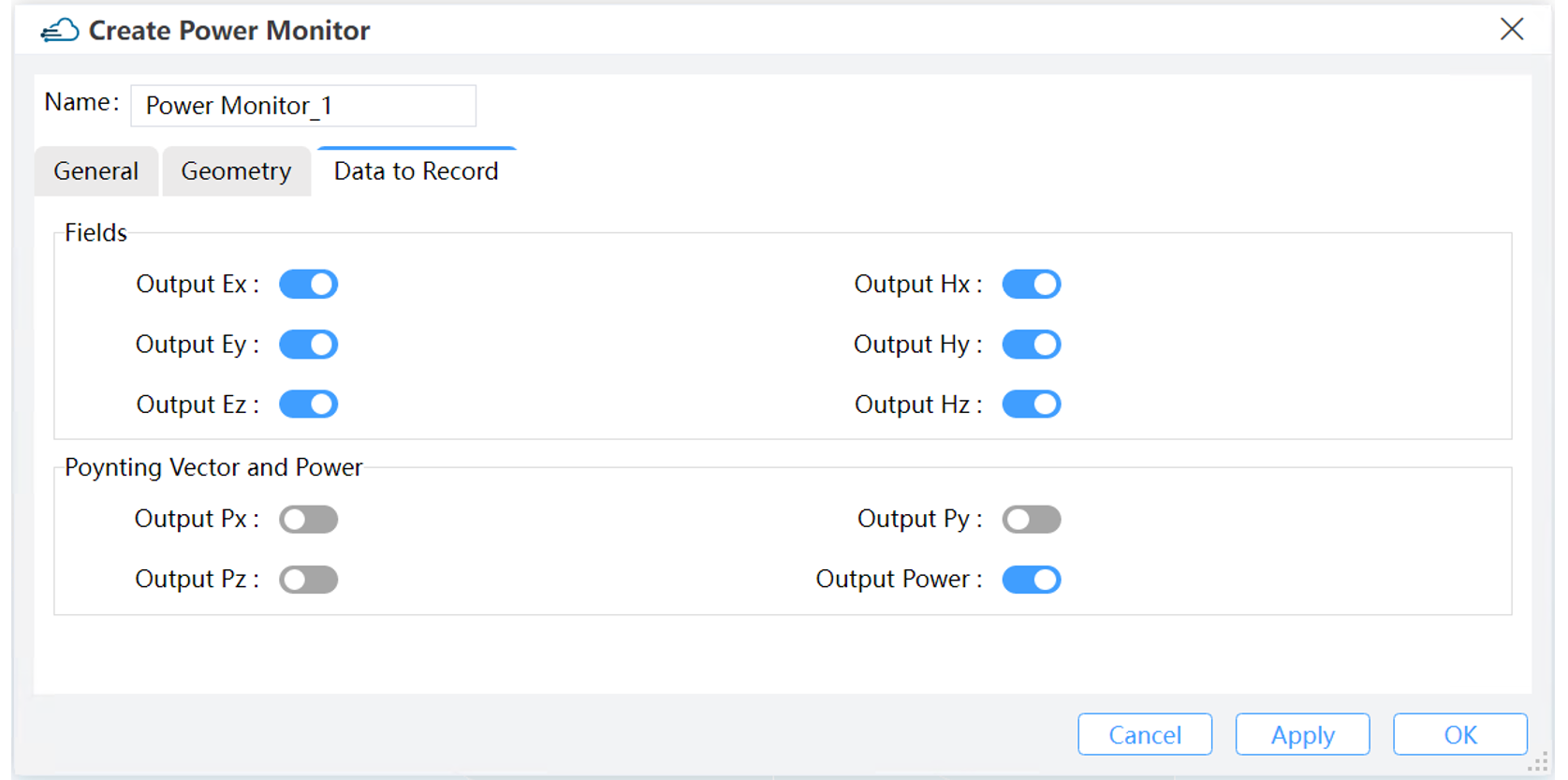 |
|---|
1) Fields: We can choose to record the electromagnetic field components of interest (e.g., Ex, Ey, Ez, Hx, Hy, Hz).
2) Poynting vector and power: The user can choose to output the Poynting Vector components of interest (Px, Py, Pz). In 2D simulations, only certain components remain non-zero in TE simulations. However, to facilitate quick switching between TE and TM simulations, all field quantities will remain activated for recording.
Note: Right-click the Frequency-Domain Field and Power monitor in the object tree, then use Preview Modes or Preview Index to preview the modes or refractive index distribution on the monitor’s cross-section. After the simulation is complete, the Mode Analysis window will pop up. Follow the same steps to select Mode Expansion Analysis, and by right-clicking the Run Analysis button, you can perform advanced analysis on waveguide or fiber modes.
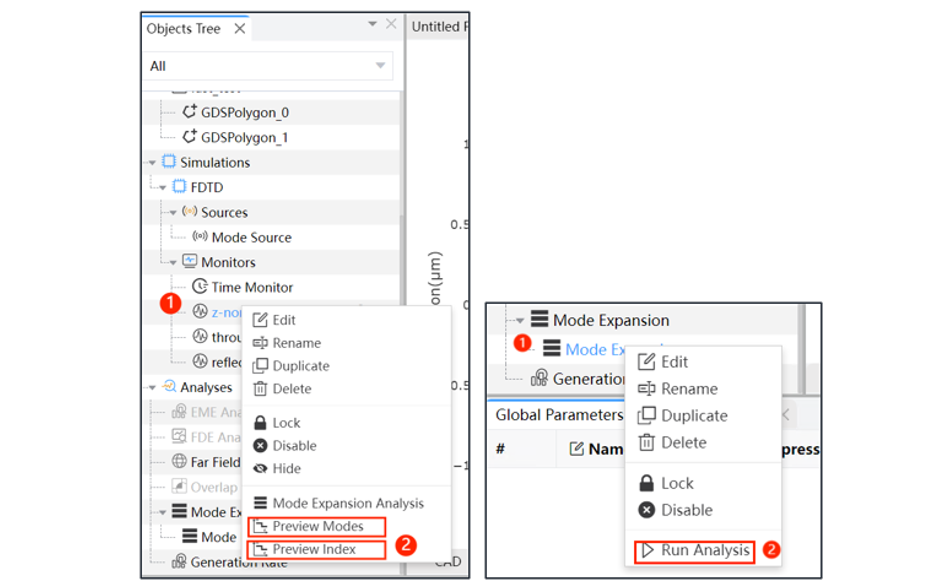 |
|---|
2.3 Global Option
Function Description: If the override global option is not enabled, the monitors added in the FDTD simulation region will use the global monitor parameter settings.
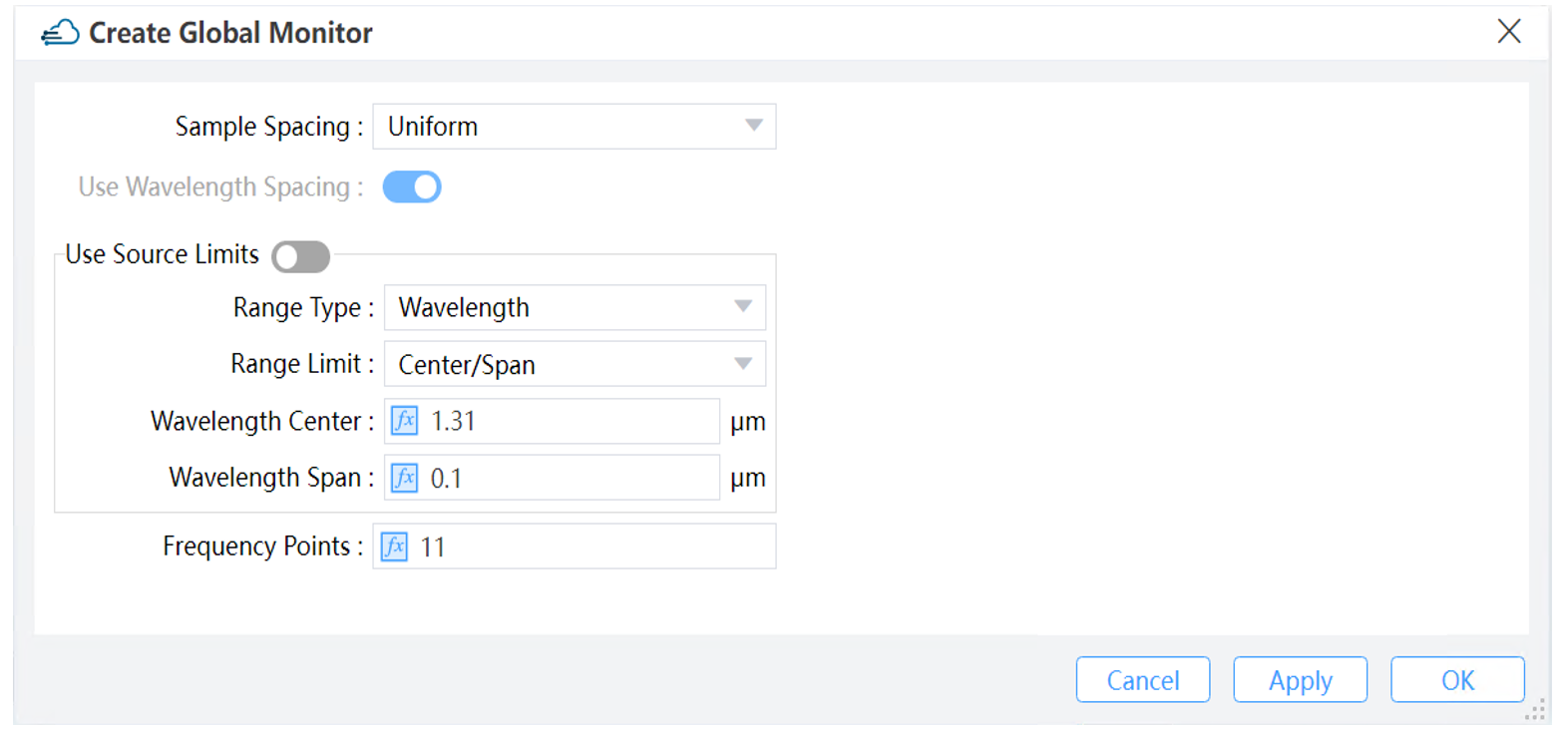 |
|---|
1) Sample Spacing: The sampling frequency or wavelength is determined in a specific manner based on this selection parameter. Currently, only the Uniform option is supported.
2) Use Wavelength Spacing: The monitor records results using wavelength intervals.
3) Use Source Limits: When selected, the wavelength range of the excitation source will be used to set the following parameters. If not selected, users can customize the range.
Range Type: Choose the type of range to set—either Wavelength or Frequency.
Range Limit: Choose the method for setting the range: Min/Max or Center/Span.
Wavelength Min: Set the minimum value for the monitoring wavelength.
Wavelength Max: Set the maximum value for the monitoring wavelength.
4) Frequency Points: Set the number of frequency points used to record data.
3 EME Monitors
EME Monitors can be used in the EME solver. The existing EME Monitors include the EME Profile Monitor.
3.1 EME Profile Monitor
Feature description: EME profile monitors work in the frequency domain to extract field profiles from the simulation results produced by an EME solver over some spatial regions.
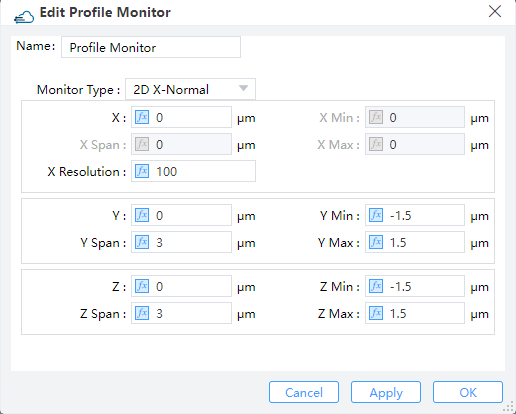 |
|---|
1) Monitor Type: This option specifies the monitor type and orientation, and will affect the availability of the spatial settings below.
2) X, Y, Z: The center position of the simulation region.
3) X Min, X Max: X min, X max position.
4) Y Min, Y Max: Y min, Y max position.
5) Z Min, Z Max: Z min, Z max position.
6) X Span, Y Span, Z Span: X, Y, Z span of the simulation region.
7) X Resolution: The number of mesh steps along propagation direction.
4 Doping Monitor
4.1 General
Data to Record:Donor: The distribution of donor doping in monitor.Acceptor: The distribution of acceptor doping in monitor.
Interpolate Accuracy: Restrained by condition: >=1 && <= 10.
4.2 Geometry
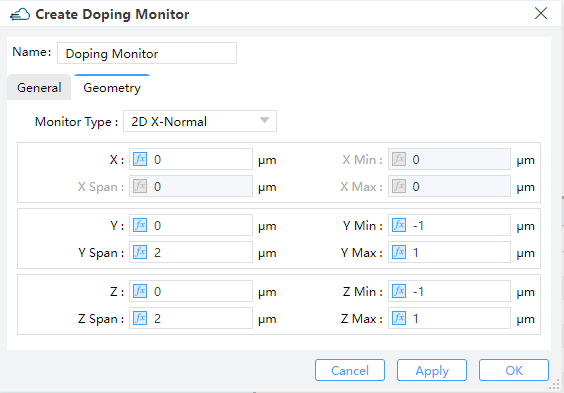
Monitor Type: The monitor type and orientation, this option will control the available of spatial setting below ,2D X-Normal,2D Y-Normal,2D Z-Normalare included. (Default: 2D X-Normal)X,Y,Z: The center position of the simulation region.X Min/X Max: X min, X max position.Y Min/Y Max: Y min, Y max position.Z Min/Z Max: Z min, Z max position.X Span/Y Span/Z Span: X, Y, Z span of the simulation region.
5 Charge Monitor
5.1 General

Data to Record:Electrons: The distribution of electron concentration in monitor.Hole:The distribution of hole concentration in monitor.Total Charge: Available when monitor_type is in “2d_x_normal”, “2d_y_normal”, “2d_z_normal”.
Interpolate Accuracy: Restrained by condition: >=1 && <= 10.
5.2 Geometry
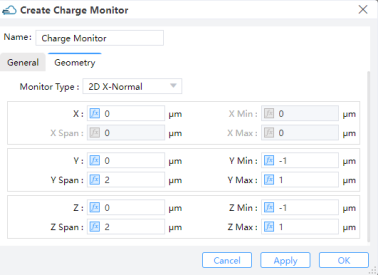
Monitor Type: The monitor type and orientation, this option will control the available of spatial setting below ,Linear X,Linear Y,Linear Z,2D X-Normal,2D Y-Normal,2D Z-Normalare included. (Default: 2D X-Normal)X,Y,Z: The center position of the simulation region.X Min/X Max: X min, X max position.Y Min/Y Max: Y min, Y max position.Z Min/Z Max: Z min, Z max position.X Span/Y Span/Z Span: X, Y, Z span of the simulation region.
6 Band Monitor
6.1 General
Name: Name of band monitorData to Record:Ec: The conduction band edge energy at 300K.Ev: The valance band edge energy at 300K.Evac: The vacuum level energy at 300K.Efn: The electron quasi-Fermi energy.Efp: The hole quasi-Fermi energy.
Interpolate Accuracy: Set the accuracy of the rectangular grid for extracting monitored results. It should be within the range of 1 to 10. Here, 1 corresponds to a grid size of 10nm, and 10 corresponds to a grid size of 1nm. The grid size uniformly varies with changes in “Interpolation Accuracy”.
6.2 Geometry
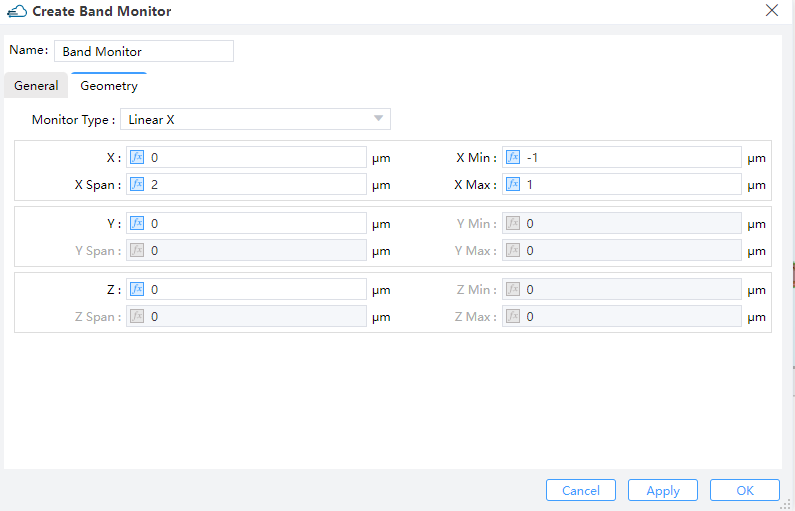
Monitor Type: The monitor type and orientation, this option will control the available of spatial setting below ,Linear X,Linear Y,Linear Zare included. (Default: 2D X-Normal)X,Y,Z: The center position of the simulation region.X Min/X Max: X min, X max position.Y Min/Y Max: Y min, Y max position.Z Min/Z Max: Z min, Z max position.X Span/Y Span/Z Span: X, Y, Z span of the simulation region.
7 Electrical Monitor
7.1 General
Data to Record:Electric Field: The distribution of electric field in monitor.Electrostatic Potential: The distribution of electric potential in monitor.
Interpolate Accuracy: Set the accuracy of the rectangular grid for extracting monitored results. It should be within the range of 1 to 10. Here, 1 corresponds to a grid size of 10nm, and 10 corresponds to a grid size of 1nm. The grid size uniformly varies with changes in “Interpolation Accuracy”.
7.2 Geometry
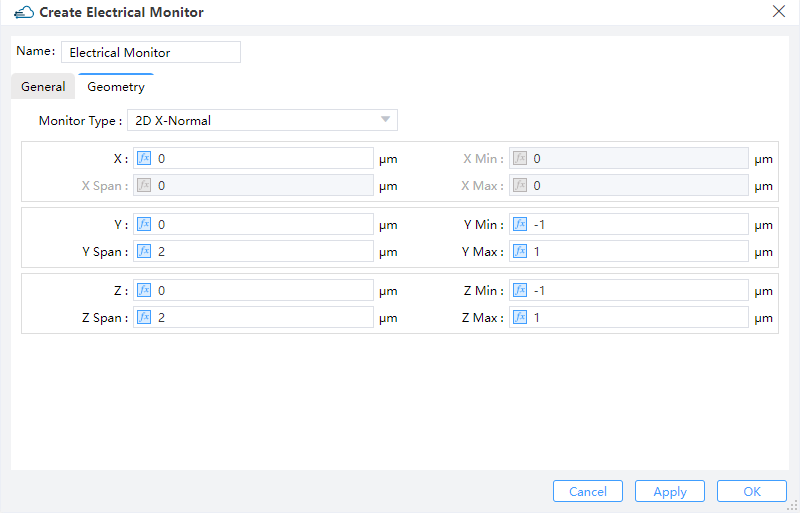
Monitor Type: The monitor type and orientation, this option will control the available of spatial setting below ,Linear X,Linear Y,Linear Z,2D X-Normal,2D Y-Normal,2D Z-Normalare included. (Default: 2D X-Normal)X,Y,Z: The center position of the simulation region.X Min/X Max: X min, X max position.Y Min/Y Max: Y min, Y max position.Z Min/Z Max: Z min, Z max position.X Span/Y Span/Z Span: X, Y, Z span of the simulation region.